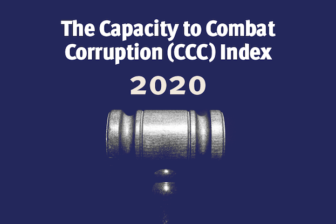To read the full 2020 Capacity to Combat Corruption Index report, click here.
From the downfall of Bolivia’s health minister to investigations into Panama’s vice president, COVID-19 is not only spreading disease and economic pain, but also corruption scandals throughout Latin America. In many ways, this was a foreseen tragedy. Months ago, organizations like Transparency International, the Inter-American Development Bank (IDB) and the OECD Anti-Bribery Group were sounding the alarm about increased corruption risks related to coronavirus emergency spending. The need to rapidly mobilize massive resources – procuring expensive medical equipment, rolling out unprecedented stimulus packages and more – could create an environment ripe for corruption. And here we are.
The timing of the crisis is particularly concerning. COVID-19 is hitting Latin America while a region-wide anti-corruption wave that gained force a few years ago has lost steam and, in some countries, is dangerously receding. The scope and scale of this change is clear in the 2020 edition of our Capacity to Combat Corruption (CCC) Index, which assesses Latin American countries’ ability to detect, punish and prevent corruption.
The CCC Index doesn’t analyze perceptions or the economic damage caused by corruption. Instead, we draw on extensive public and proprietary data to assess the environment that allows – or precludes – countries to better tackle the problem. This environment is formed by multiple factors ranging from the independence and efficiency of courts and law enforcement agencies to the strength of democratic institutions, NGOs and investigative journalism. We understand that there is no silver bullet capable of drastically improving countries’ capacity to combat corruption. Real progress is only achieved through long-term and parallel gains in government, business and civil society.
The country with the highest score in the 2020 CCC Index is Uruguay (7.78 out of 10), meaning that it is more likely to see corrupt actors prosecuted and punished than the other countries. Uruguay was followed by Chile (6.57), Costa Rica (6.43), Brazil (5.52), Peru (5.47), Argentina (5.32), Colombia (5.18), Mexico (4.55), Ecuador (4.19), Panama (4.17), Guatemala (4.04), Paraguay (3.88), the Dominican Republic (3.26), Bolivia (2.71) and Venezuela (1.52). The score is composed of three sub-categories: legal capacity; democracy and political institutions; and civil society, media and the private sector.
The index was originally launched in 2019. For the 2020 edition, we increased the number of countries analyzed from eight to 15 (accounting now for almost 95% of the region’s GDP) and expanded the network of in-country experts surveyed.
Shades of graft
The 2020 CCC Index ranking reveals a region divided into four groups. The first one – composed of Uruguay, Chile and Costa Rica – features closer to the OECD average for governance indicators than to the Latin American average. The region’s high achievers have each had embarrassing corruption cases in past years, but they also have better tools to deal with the problem – from putting people in jail to effective control mechanisms.
Brazil, Peru, Argentina and Colombia form the second group. Their anti-corruption environment is uneven: all have achieved substantial improvements in some areas, but still face critical challenges in others. And importantly, they are on different trajectories: Compared to last year, Brazil’s score dropped and Peru’s increased, while Argentina and Colombia have stagnated.
Mexico, Ecuador and Panama form the third group: countries that saw progress only in limited areas, but score below the regional average across several variables. The fourth group is consistently behind the rest of Latin America in virtually all 14 areas assessed: Guatemala, Paraguay, the Dominican Republic and Bolivia. Finally, as a kleptocratic dictatorship, Venezuela stands in a separate category, isolated at the bottom of the ranking for the second consecutive year, and with an even lower score than last year.
Looking at specific countries, Brazil is one of the most concerning cases. Although it still ranks fourth in the index, Brazil saw a 10% decline in its overall score, driven by setbacks in the legal capacity sub-category, which dropped 14% year-on-year. President Jair Bolsonaro’s pick for attorney general and changes in the Federal Police’s leadership, as well as judicial decisions negatively impacting white-collar crime investigations, are leading causes for the downward trajectory.
The second-largest Latin American country, Mexico, also serves as a cautionary tale. President Andrés Manuel López Obrador (AMLO) came to power with a promise of “ending corruption,” and the topic has firmly remained at the top of his agenda. However, the 2020 CCC Index shows that, in practice, not much has changed. Despite the president’s rhetoric, the country has stagnated and maintains a poor ability to detect, punish and prevent corruption. Mexico’s overall score, as well as the scores for all three sub-categories, remained strikingly similar to last year’s.
Meanwhile, Peru is the most positive story in the 2020 CCC Index, with an almost 6% increase in its overall score since last year, and an 11% increase in legal capacity. The change reflects gains in law enforcement capacity, the court system and civil society, as well as the importance of anti-corruption on President Martín Vizcarra’s agenda. These advances – combined with some adverse outcomes in other countries – have put Peru very close to Brazil and ahead of Argentina and Colombia in this year’s ranking. Last year, Peru lagged behind all three.
The COVID-19 crisis will continue to pose an unprecedented test to all Latin American countries, and we will likely see more corruption scandals popping up across the region. Yet the pandemic can also create an opportunity to focus again on practices and policies that really make a difference in fighting corruption. We know what they are – from increasing the efficiency and independence of courts to creating greater transparency in the relationship between money and politics. The key challenge will be creating political conditions conducive to this reform agenda.
—
Simon is the Senior Director of Policy at AS/COA and Politics Editor of Americas Quarterly
Aalbers is a Partner at Control Risks








